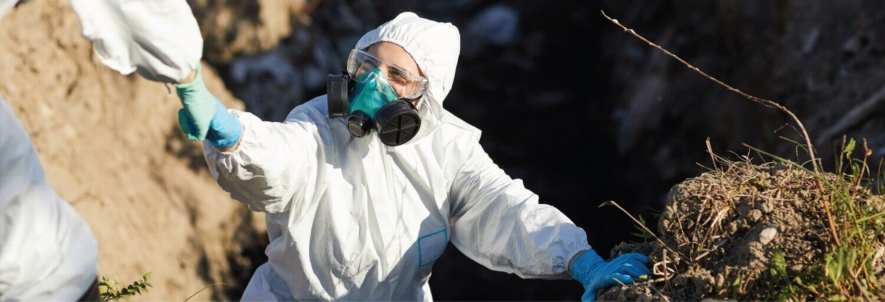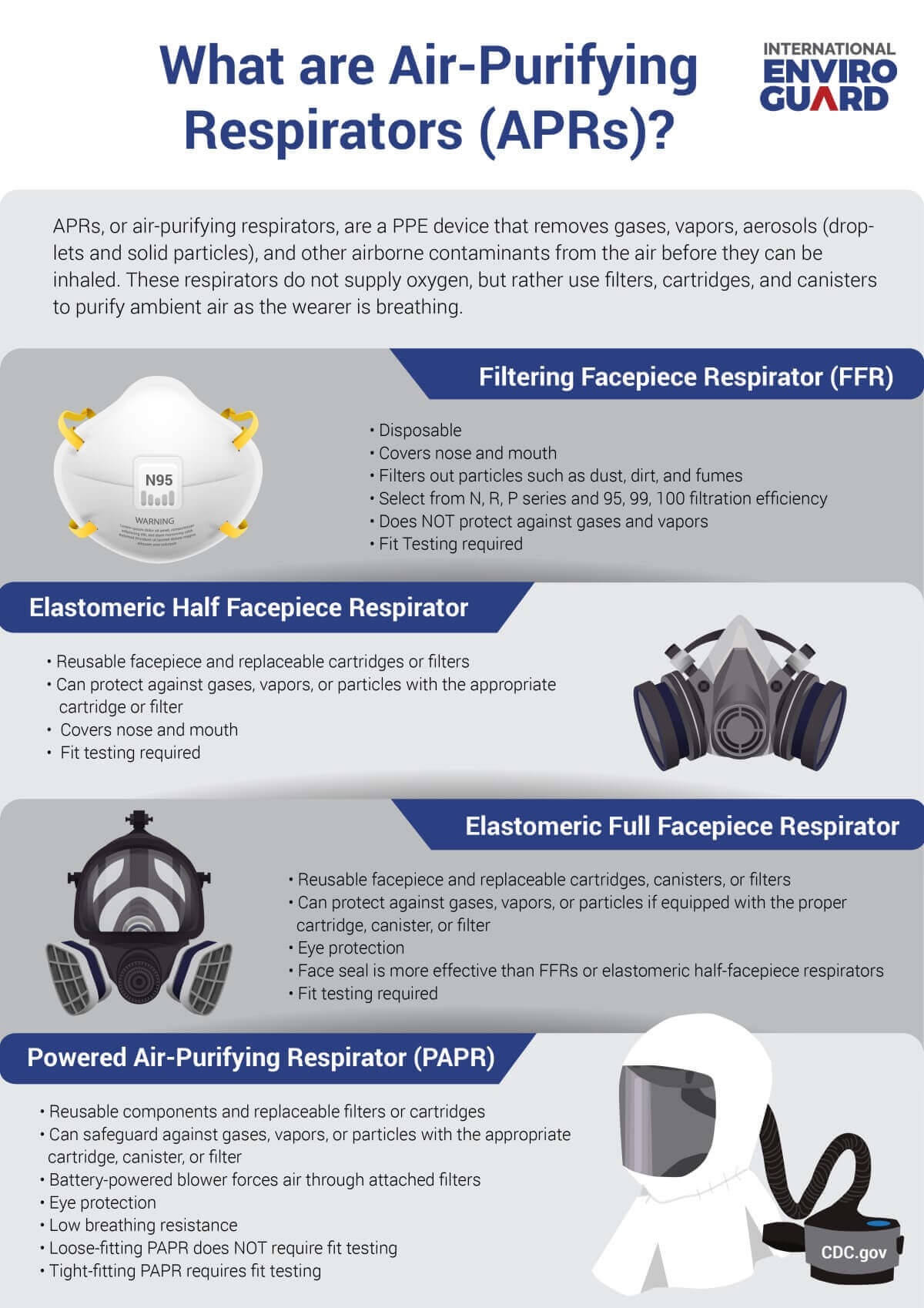
If you’re exposed to vapors, gases, infectious respiratory droplets, or other airborne particulates within your work environment, it's critical to protect your respiratory system—your short-term and long-term health depend on it.
According to the Occupational Safety and Health Administration (OSHA), exposure to potentially harmful airborne contaminants can lead to temporary symptoms like dizziness, headaches, nausea, wheezing, and itching or burning of the throat, skin, and eyes. Some toxic chemicals can also lead to long-term or chronic effects, such as liver damage, infertility, or an increased risk of lung cancer. Chronic effects may take several years to show up and can vary depending on the amount and type of exposure.
Clean workplace practices—such as the use of ventilator hoods and protective clothing—will help reduce your exposure to potentially harmful airborne compounds. But in many occupational environments and situations, personal air purification is necessary, as well.
Air-purifying respirators (APRs) are wearable devices that provide cleaner air for the wearer and significantly reduce their risk of toxic substance inhalation. There are several air purifying respirator devices. One popular option is known as a powered air-purifying respirator (PAPR).
This article introduces some important things to know about PAPRs and other common types of respirators. The goal is to help you understand when each type should be used, what substances they do (and don't) protect against, and how to select the correct one for your specific needs and job application.
What is a PAPR?
Like other air purification systems, a PAPR is a wearable device that removes dust, fumes, and other airborne contaminants from the air. This helps make the air safer to breathe and reduces a person's exposure to potentially harmful substances.
PAPRs are battery operated and include a half or full facepiece attached to a breathing tube. The other end of the breathing tube is attached to a battery-operated blower, typically worn around the wearer's waist. The battery-operated blower contains high-efficiency particular air (HEPA) filters and/or cartridges.
How Does a PAPR Work?
A PAPR uses the battery-powered blower to force ambient air through the HEPA filter and/or cartridge. The filter traps and removes contaminants from the air, leaving behind purified air for the wearer to inhale. This purified air is then sent through the tube and into the breathable zone inside the half or full facepiece.
Pros and Cons of a PAPR Respirator
PAPRs only purify the air—they don't supply oxygen. This means PAPRs should never be used in environments when there is low oxygen. PAPRs may not be appropriate in other situations, too, such as when there is an unknown contaminant or when the contaminant level exceeds the ability of the PAPR to protect the person wearing it.
In some cases, the wearer may have a hard time hearing due to the noise of the PAPR's blower equipment and/or the normal movement of the head covering. PAPR batteries must also be recharged or replaced routinely. If your facility uses PAPR equipment, it's incredibly important to remain organized in the storage and routine maintenance of the respirator batteries and related equipment.
However, PAPRs do offer several benefits that other types of air-purifying respirators don't. Generally speaking, PAPRs offer more protection against aerosolized pathogens and other contaminants than N95s or other non-powered air purifying systems. This makes them ideal for healthcare providers who might be exposed to infectious respiratory droplets.
As noted by the U.S. Centers for Disease Control and Prevention (CDC), PAPRs may also be easier to breathe in and less difficult to wear compared to other respirators. Many PAPR components can be disinfected, cleaned, reused, or even shared among workers, which promotes improved cost-efficiency in the workplace. Depending on the design, a PAPR respirator might also offer significant splash protection for a person's face and eyes, and improve the ability of the wearer to see and communicate with others.
Two main types of PAPRs exist—loose-fitting and tight-fitting.
Loose-Fitting PAPRs
A loose-fitting PAPR respirator is the more appropriate choice for wearers who have a limited amount of facial hair. This type of PAPR features a hood that covers the entire neck and head. These devices don't require fit testing (fit testing is discussed more thoroughly later in this article).
Tight-Fitting PAPRs
A tight-fitting PAPR is intended to create a tight seal around the face of the person wearing it. More importantly, a tight-fitting PAPR cannot be worn by someone with facial hair.Tight-fitting PAPRs are available in one of three types: quarter mask, half mask, or full facepiece. In order to wear a tight-fitting PAPR, a person must be fit tested for it. Keep reading to learn more about what respirator fit testing entails.
Getting the Right PAPR For Your Needs—The Importance of PAPR Fit Testing
Fit testing is a process used to determine whether a respirator fits comfortably and correctly for an individual wearer. Not all respirators (such as loose-fitting PAPRs) require fit testing. But for the ones that do require fit testing, the process is incredibly important. This is because wearing a respirator that doesn't fit you properly can dramatically reduce the respirator's effectiveness and therefore increase your risk of exposure to harmful airborne chemicals or pollutants.
What Happens During a Respirator Fit Test?
During a fit test, a person is exposed to a test substance, such as a non-hazardous pungent odor or an irritant smoke, while wearing the respirator. If the person can smell or taste the test substance while wearing the respirator, this means the respirator does not fit correctly. This type of fit test is also known as a qualitative fit test.
Some fit tests use quantitative measurements instead. Quantitative fit testing involves a machine or instrument that takes measurements to determine if there is any air leaking out around the respirator's facepiece.
The type of fit test required for a given PAPR depends on several factors, including the respirator manufacturer's specifications. No matter which type of fit testing is performed, it's important to complete these tests thoroughly and as often as required.
Other Types of Air Purifying Respirators (APRs)
Depending on factors unique to your situation, a PAPR might not be the most appropriate option for protecting your airways while at work. In these cases, several other air purifying options exist for your air purification and respiratory protection needs.
The following is a list of the main APR alternatives:
- Filtering Facepiece Respirator (FFR): FFRs are disposable and cover only the nose and mouth. They filter out particles like fumes, dust, and mist, but do not protect against vapors and gases. Common examples include N95 respirators, although other series and efficiency levels exist (e.g., series R or P and efficiency level 99 or 100). N95 is a government efficiency rating that means a mask blocks 95% of airborne particles 0.3 microns or larger. A person needs to be fit tested to wear FFRs.
- Elastomeric Half Facepiece Respirator: This type of respirator is reusable and contains replaceable filters or cartridges. Like FFRs, they also cover only the nose and mouth and require fit testing to be worn. However, elastomeric half facepiece respirators do offer protection against vapors, gases, or certain other particles so long as it contains the appropriate filter or cartridge.
- Elastomeric Full Facepiece respirator: This type of respirator protects against the same kind of contaminants as an elastomeric half facepiece respirator, however, it also offers eye protection since it covers the entire face. A properly fitting elastomeric full facepiece respirator will also provide a more effective seal than both half facepieces and FFRs. As with the other types of APRs, fit testing is required.

Overall, the type of APR you need depends on several factors including:
- The type of contaminants you might be exposed to
- The concentration of contaminants in the environment
- The length of time of exposure
- The relevant occupational exposure limit
- The type of work or application
- Physical characteristics of the wearer (including, whether a person has facial hair or not)
- The limitations of the respiratory device
No matter which type of APR you use at your facility, it's important to be properly trained on how to don, doff, clean, store, and care for the device.
Conclusion
Many occupational environments—including industrial, medical, laboratory, and manufacturing—involve work tasks and duties that expose workers to hazardous airborne materials. Such materials include gases, vapors, fumes, dust, and infected aerosolized particles. Breathing in these potentially harmful chemicals can lead to short- and long-term health consequences for the worker.
Wearing an appropriate respirator is one of the most effective ways to reduce your exposure to airborne particles and protect your airway while on the job. Several types of respirators exist, ranging from powered air-purifying respirators (PAPRs) to N95 respirators and more. Knowing which type of respirator is the most appropriate for your situation is imperative to keeping you safer and helping you breathe cleaner air while on the job.
Visit International Enviroguard today to discover more workplace safety solutions or contact us with questions about your occupational needs.
